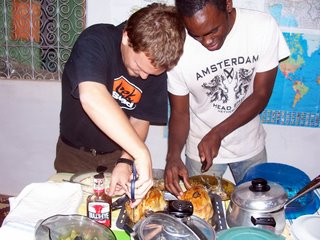A Late Thanksgiving Wish!
We are a little late, but we want to wish everyone a Happy Thanksgiving! We hope you had a meaningful holiday wherever you are, and whatever you ate! If it was turkey, okay, we are a little jealous... but, even without turkey, we have oh-so-much to be thankful for, and a lot of our gratitude is for the dear family and friends who read this from time to time, and we want you to know we love and miss you!
Time for some pictures! We remembered to get our camera out for a Thanksgiving fiesta this past weekend...
 Aaron and April swung by our place on their way into town, and participated in our kitchen beautification project/guestbook. :) Our kitchen walls are plain cement and are begging to be drawn on! You should come visit and draw too! No, I mean it. Come visit! :)
Aaron and April swung by our place on their way into town, and participated in our kitchen beautification project/guestbook. :) Our kitchen walls are plain cement and are begging to be drawn on! You should come visit and draw too! No, I mean it. Come visit! :)
The feast took place at the home of one of our fellow Tata volunteers and a darn cool gal (um, she's in a pic in a minute) but one aspect of her beautifully decorated home is this very comfy hammock, demonstrated here by my handsome husband.
 There is our hostess with the mostest! Vanina and Aaron and I... I'm sure we were doing something important... or they were anyway... peeling something...
There is our hostess with the mostest! Vanina and Aaron and I... I'm sure we were doing something important... or they were anyway... peeling something...
The two Tata Michaels carving the chickens... :) So much food... so good...
 We took a tour of Vanina's village, which is filled with cool passageways and tunnely areas, but unfortunately none of the pictures turned out but this one!
We took a tour of Vanina's village, which is filled with cool passageways and tunnely areas, but unfortunately none of the pictures turned out but this one!
And finally, Van and I putting up her Christmas decorations. We are very proud of our little tree. :) Thanks Vanina for letting me help! Without a non-stop Christmas radio station, day after Thanksgiving sales, and well, really cold weather, it sometimes just doesn't feel like the end of November, but it is surprising how hanging tinsel and putting up ornaments makes you feel all festive...even in the desert. :)
I'm not sure if Sudan is in the news there as much as it is on the BBC around here, but if it isn't, it really should be! I found an interesting link today that rates your state's politicians actions in relationship to Sudan. See how your people are doing... http://www.darfurscores.org/
If you are interested in learning more about the genocide occurring in Sudan, check out these links and please, please take action!!
Two blog-style sites with updated information and news about Sudan:
For good measure BBC on Sudan
"Sleepless in Sudan" is the blog of an aid worker who, although now posted elsewhere, was blogging her experiences straight from Darfur. It is worth reading through all of her blog, but this post is all about what we can do to help.
I know if you've read our blog for a while, a lot of this info is not new, but hopefully this is new for someone, or maybe today it finds you at a time where you have a free minute to investigate. Not to go all drama girl on the blog, but this is our chance to ask those in power to do something (!) rather than look back and remember the tragedy and wonder what we could have done... okay, rant concluded. Thanks for listening. :)
 Come with us as we travel to Morocco with the Peace Corps to learn more about each other, ourselves, and what we'd like to be when we grow up.
Come with us as we travel to Morocco with the Peace Corps to learn more about each other, ourselves, and what we'd like to be when we grow up.

